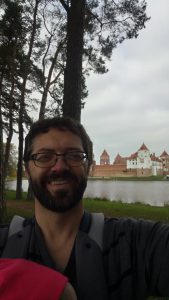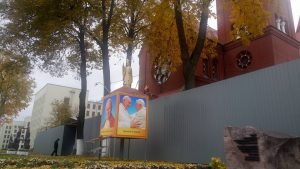NOTE: Unfortunately, I just realized that I never published this page. So I am updating it a bit before publishing it…
I had the privilege of giving an open lecture series on the Renaissances of American Literature at Belarusian State University during the last of October and part of November. Some people here in Belarus know little about American culture, and others surprise me with how much they know. Included in this series are the following topics and Belarusian responses. (All dates are approximate, of course, and many of these movements had “second waves.” I invite any reader to fight with me about this!)
AMERICAN RENAISSANCE (IN LITERATURE), 1830-1860

Of the “Big Five,” (the dead white men F.O. Mattheissen enshrined as the purveyors of literary culture in the mid-nineteenth-century), students know relatively little. I was surprised that even Walt Whitman was not well-known here. But they really know Edgar Allan Poe (who was not one of Mattheissen’s “Big Five”). Poe has been translated into Russian and Belarusian, so they learn some of his work even before attending university. A few of them know that Nathaniel Hawthorne is associated in some way with the Salem witch trials. They know even less about other writers of the American Renaissance — particularly the women and African Americans who have been restored our knowledge of nineteenth-century literary culture in the United States. With one major exception. Emily Dickinson’s voice has been heard here! I credit that to the faculty expertise in women’s literature in my department. Hanna Butyrchyk, the department chair, teaches women’s literature and postcolonial literature. And Natallia Lameka and others in the department are quite familiar with Dickinson’s work as well. She who wrote “There is no frigate like a book / To take us lands away” is present here, lands away and times away from her nineteenth-century New England home in Massachusetts.
Speaking of dead white men, I am apparently doomed to that category. And I even wrote my dissertation about one of them, despite being told I’ll never get a job that way. Maybe the fact that I also obsess about non-dead people, non-white people, non-male people makes me more attractive than a partisan for dead-white-men and dead-white-men alone. Maybe!
HARLEM RENAISSANCE, 1920-1940 (& JAZZ & PIE)
The Harlem Renaissance takes us sharply away from dead-white-men. African-American literature is somewhat well-known here, especially the work of one of my favorites — Zora Neale Hurston. I teach Hurston’s book Their Eyes Were Watching God whenever I get the chance, and I’m also enchanted by the poetry of Langston Hughes (of course!). I played a verse of the black national anthem, James Weldon Johnson’s “Lift Every Voice and Sing” as well as a jazz piece rising from that era. I was going to invite distinguished scholar in American Studies Dr. Yuri Stulov from a neighbor institution for my lecture since he specializes in African American literature, but I failed to do so in time. (Probably because I’ve been taking every chance we get to travel around the city and the country with my family — more about that in my next blog.)

Incidentally, I walked down the street to a pie/pastry shop (Кафе Stolle) for coffee with a student right after the lecture on the Harlem Renaissance, and we heard a Louis Armstrong song playing there. They play jazz at this cafe fairly frequently. Another time, I was in this shop and saw two young women from one of my classes entering. I said, “Hey Ladies!” but they walked on, turning around a little later and coming back to greet me. “I heard you, but I just thought it was some guy trying to be cool, speaking English!” But this turned into a conversation about Jazz as well since one of the young women there is doing her 5th-year writing project (i.e. senior thesis) on Toni Morrison’s book Jazz. The study of African American literature seems alive and well here.
SOUTHERN RENAISSANCE, 1925-1960
The Southern Renaissance takes us beyond the Lost Cause narratives of the South as a romanticized place that was lost after the civil war (think Gone With the Wind) to think about the American South in the modern era. William Faulkner is the most well-known of these writers, but this Renaissance also includes the “New Critics” and Southern Agrarians as well as the Southern Gothic writers (e.g. Flannery O’Connor, Tennessee Williams, etc.) as well as writers whose work would contribute to the Civil Rights era (e.g. Richard Wright). And I played a clip of the unusual transformation of a Robin Hood-like tale set in the American South in Eudora Welty’s Robber Bridegroom (turned into a Broadway show in the seventies). I think my attempts to speak in a Southern accent created more hilarity than elucidation, but it probably helped to prepare for the clips I showed.
NATIVE AMERICAN RENAISSANCE, 1968-1990
And why, you ask, do I give a specific year for this renaissance rather than giving an approximate year as I did for all the others? I’m glad you asked! It’s because the beginning of this Renaissance is almost always linked to N. Scott Momaday’s Pulitzer-Prize winning novel House Made of Dawn. This book brought Native American writing to the attention of the so-called literary “mainstream” and marked a shift away from stereotypical/Hollywood/popular representations of “Indians” as peculiar “redskins.” One particularly-motivated graduate of BSU who visits my classes and lectures is investigating a project on Leslie Marmon Silko and was delighted to find that I have been in the august presence of Silko herself!
After this final lecture on the American Renaissances, a few attendees (not just my students) asked to have their pictures taken with me. Apparently I’m being treated to a whiff of celebrity status! (Haha!) Even those who didn’t seem to know the authors and texts I discuss seemed to like my speaking — or maybe my gestures. Or maybe they like the music/culture video clips I have been including. But most likely, they are simply mesmerized by my brilliance!! (Or not!)
“People stop thinking when they cease reading.” – Denis Diderot
WHY I STUDY LITERATURE & OTHER MATTERS
In my classes, I asked all of my students to write a brief essay titled “Why I Study Literature.” While I’m still analyzing the results, I’ve found that many of them have latched onto an excellent quote by Denis Diderot: “People stop thinking when they cease reading.” I wanted to see what (American and other) authors Belarusian students read, and I’ll share the results in class as well as at Indiana University East when I return.

I realized today (Monday, November 13) how much I have acclimated to life in Minsk. I had some business to transact at a bank and translation agency near Lenin Square. As I stood in line and answered the question of a local in line with me. I guessed at what he was asking and gave him my guess of an answer with a few words in Russian. But then I second-guessed my answer and told him (in Russian) that I don’t really speak Russian. So he started speaking English to me, asking me where I’m from and getting that same excited half-grin that some people here get when they realize they are speaking English to an American. Several people have asked me if their English is actually understandable because they so rarely speak to someone “all in English” that they aren’t sure. After transacting my bank business, I rushed through some streets and got some documents I had an agency translate for me, then rushed back to the metro in record time — all while passing by historical sites that have become quite familiar to me.
I will also give a two-lecture series on Teaching English, and I have been asked to write an article on American Literature for a Belarusian literary journal. More on this next month…
Discover high-quality replica Patek Philippe watches that perfectly replicate the luxury of the original designs at unbeatable prices.

